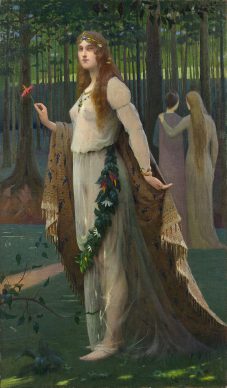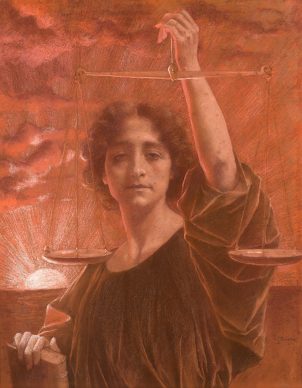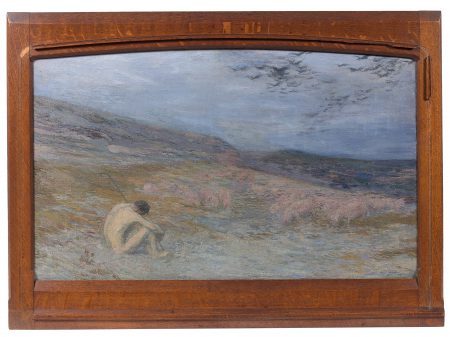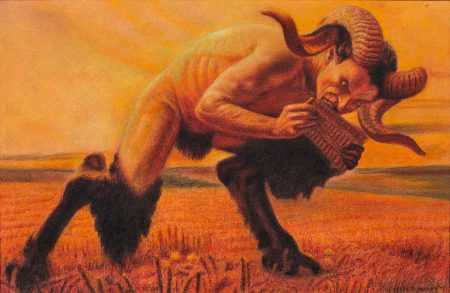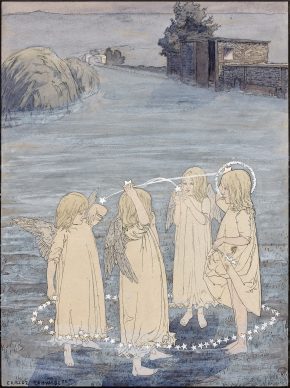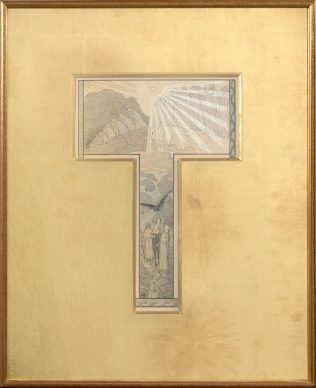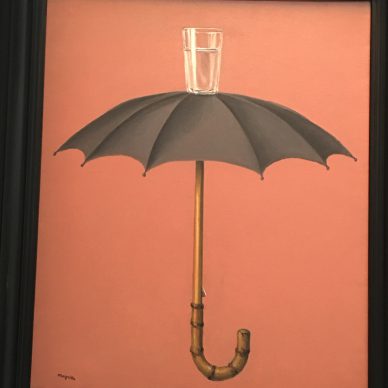While listening to Wagner and seeking inspiration in Baudelaire, they went in search of the sublime, the mystical, and the mysterious.
This singular group reached its apex in 1892, when Péladan established an annual painting salon called the Salon de la Rose Croix.
An exhibition dedicated to the phenomenon and to the salon, which was held every year until 1897, is currently showing at the Guggenheim Museum in New York until 4 October.
The artistic movement, if we can call it a movement, cannot be said to have achieved great fame.
It’s true that the artists who formed it are widely represented in international museums such as the Musée d’Orsay, but the group only constituted a minor episode in the history of art.
Afterwards, they all went their separate ways.
Yet Péladan’s theories are said to have influenced a number of key figures in the history of modern art, including Kandinsky (1).
Commercially speaking, a “symbolist market” in the strict sense is virtually nonexistent.
Yet on 26 September in Paris the auction house Artcurial is dedicating an entire sale to the subject.
In fact, it is breaking up a private collection (80 lots) compiled over the course of 30 years by a lawyer from Brescia, and supplementing it with 56 other artworks in the same vein.
The notion of “symbolism” used in the sale is far more elastic than in the Guggenheim exhibition. It extends to artists who simply have a taste for the mystical.
Parisian private dealer and Old Masters specialist Etienne Bréton emphasizes, that “Symbolism is one of the few areas that allows for the accumulation of a museum-standard collection with limited means.”
The term “symbolist” was coined by the poet Jean Moréas in 1886, who wanted “to clothe the idea in perceptible form”, in other words to make visible the intangible elements of the mystical order.
One of the emblematic leaders of the group is Lucien Lévy-Dhurmer (1865-1953).
His record price at auction rose to 298 000 euros in 2011 for an orientalist watercolour.
Artcurial presents 10 artworks by Lévy-Dhurmer, including “Justice” (“La justice”) (estimated at 10 000 euros), a pastel work in shades of brown. Dating from around 1906, it depicts a woman holding a set of scales in reference to the exoneration of Captain Dreyfus, according to Matthieu Fournier, Old Masters expert at Artcurial.
Before becoming a successful post-impressionist painter, Henri Martin (1860-1943) went through a symbolist phase that led him to exhibit at the Salon de la Rose Croix in 1892.
“The Prodigal Son” (“L’enfant prodigue”) from 1897 depicts a landscape in pastel shades with a nude male figure sitting on the ground, almost blurring with the natural surroundings (estimation: 20 000 euros).
The now forgotten Maurice Chabas (1862-1947) was a fervent activist for symbolism.
He exhibited at the fifth Salon de la Rose Croix in 1896 with the spectacular painting “Nemea” (“Néméa”), which Artcurial presents on 26 September.
Joséphin Péladan writes: “There is something of the physical and moral race in this proud and delectable woman.” While the subject’s head may be a little too masculine, the rest of this classical-style scene is particularly accomplished, painted with, among other things, trees whose grid-like trunks produce an almost geometric effect. The historical painting is estimated at 15 000 euros.
The German Carlos Schwabe (1866-1926), who lived in Paris, designed the poster for the first Salon de la Rose Croix. It is on display at the Guggenheim as well as being auctioned by Artcurial with an estimation of 1500 euros.
His paintings rarely sell for more than 100 000 euros. His record price was obtained in 2017 for the watercolour drawing “Silence Within” (“Silence intérieur”), which sold for 173 000 euros.
At Artcurial, his impressive pastel and sanguine piece “A Faun Playing the Flute” (“Faune jouant de la flute”) from 1905-1906 depicts a demonic creature cast in an apocalyptic light (estimation: 15 000 euros).
As chance would have it, another artwork by Carlos Schwabe exhibited at the Salon de la Rose Croix is due to be presented, again by Artcurial, on 10 October. This particularly accomplished gouache piece, “The Game” (“Le jeu”), which could well have merited the honours of the Guggenheim, depicts a group of angelic young girls (estimation: 3000 euros).
A paltry sum compared to the prices of the contemporary art world.
(1) For more on this subject, see the well researched article by Alex Ross, “The Occult Roots of Modernism”, published in the New Yorker, 26 June 2017.
Support independent news on art.
Your contribution : Make a monthly commitment to support JB Reports or a one off contribution as and when you feel like it. Choose the option that suits you best.
Need to cancel a recurring donation? Please go here.
The donation is considered to be a subscription for a fee set by the donor and for a duration also set by the donor.


